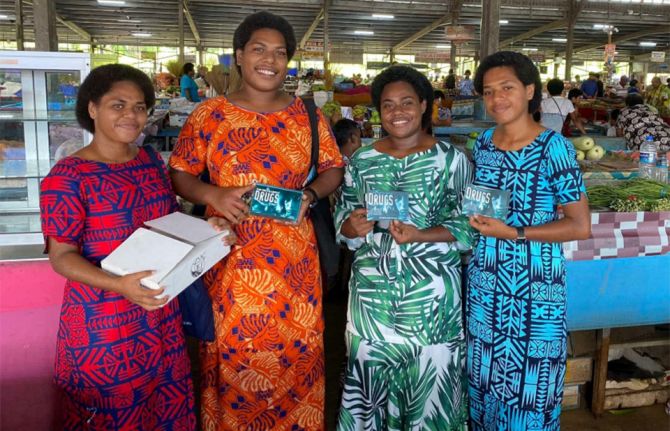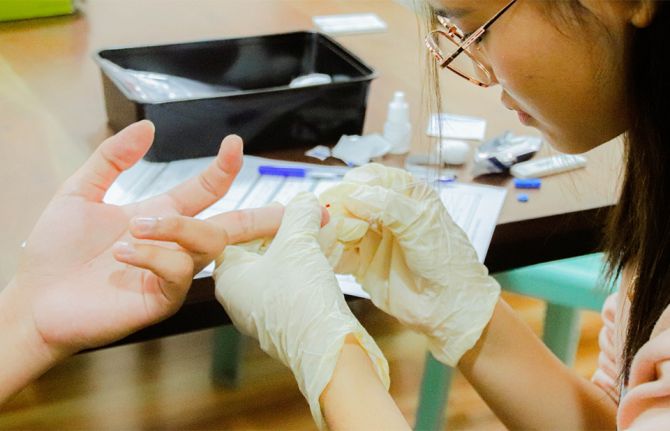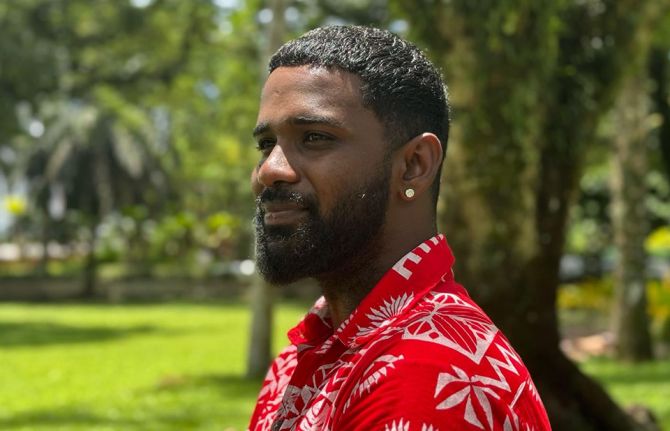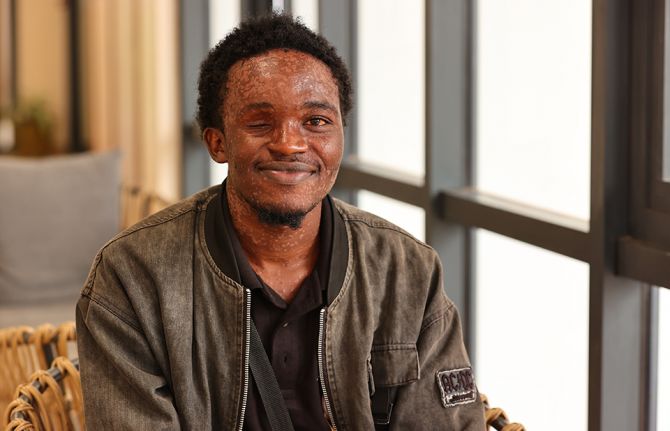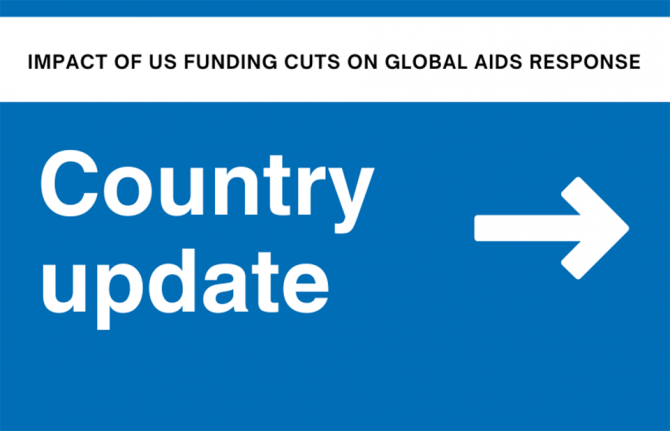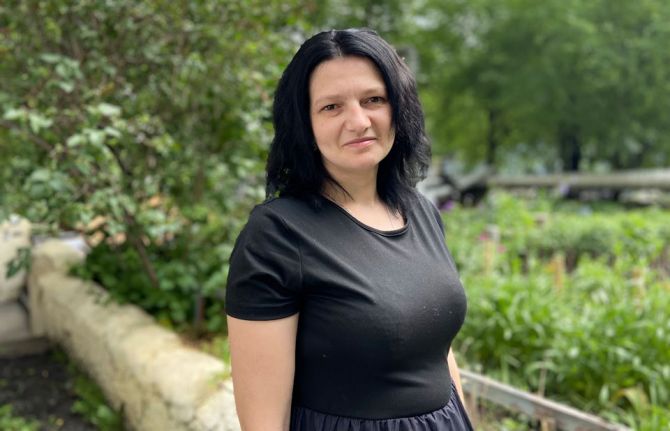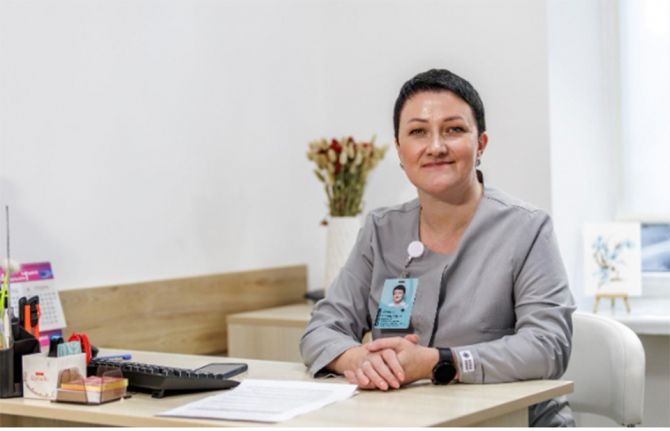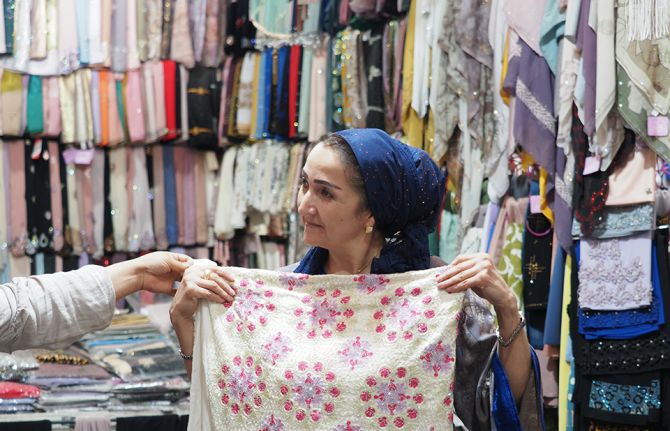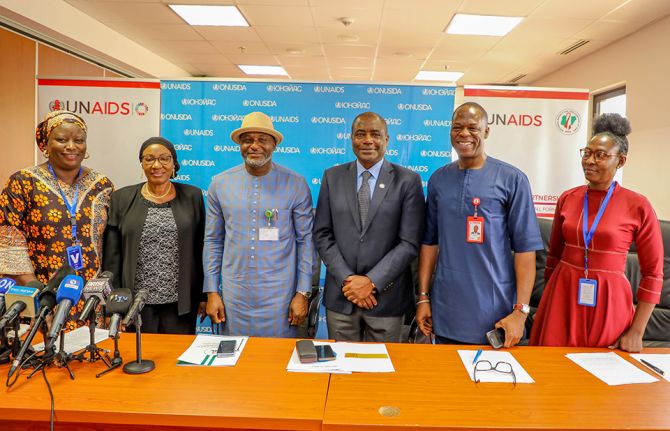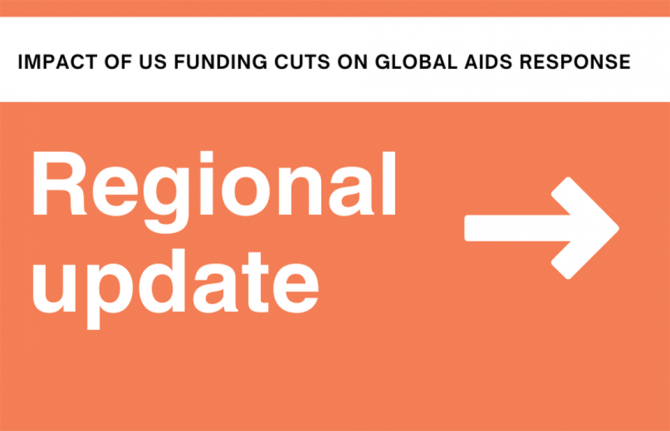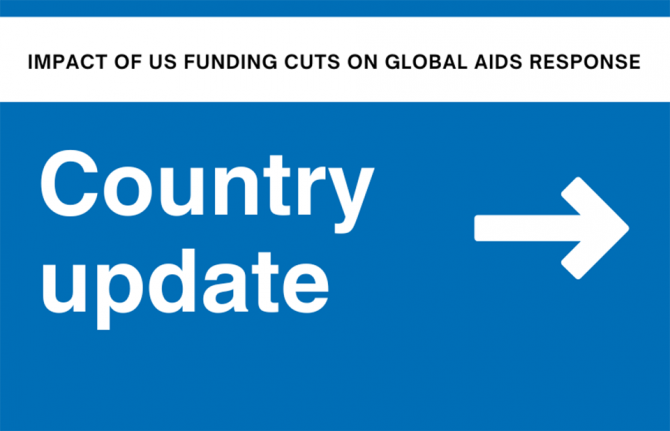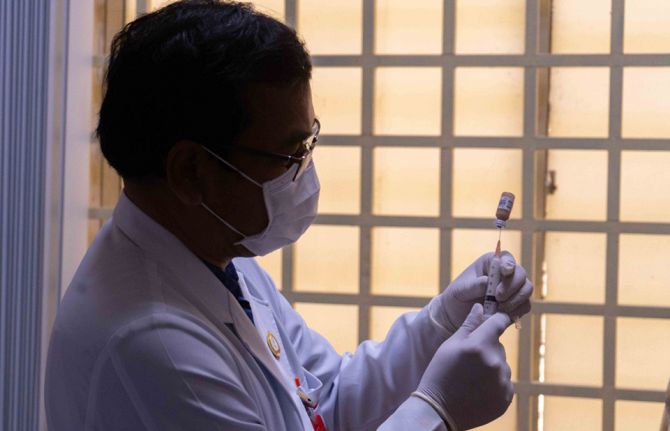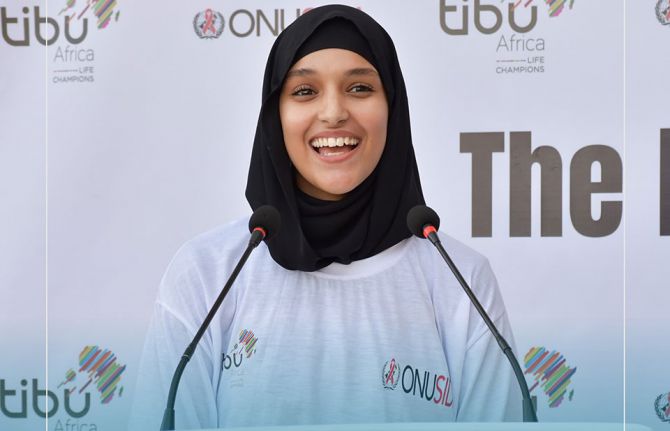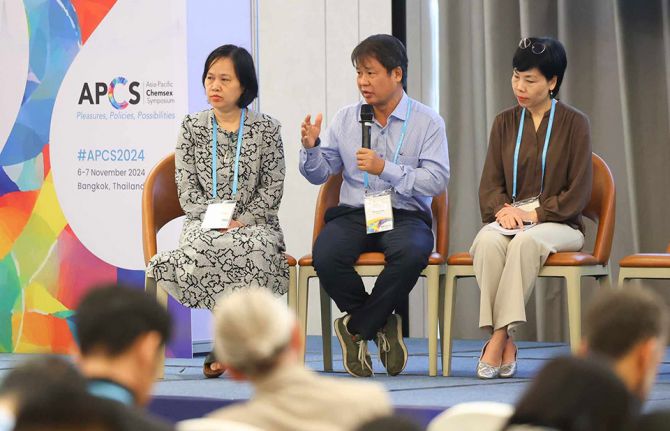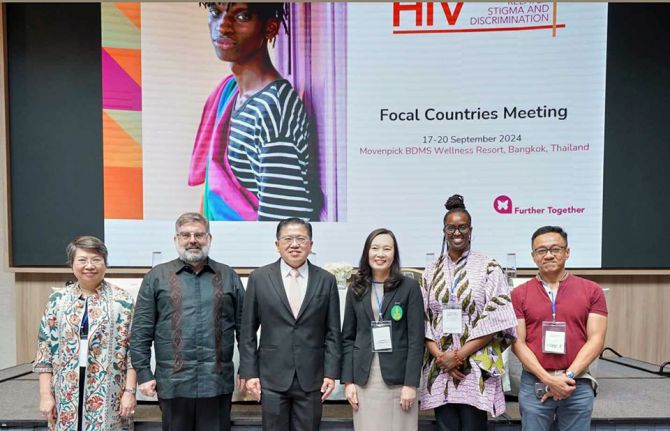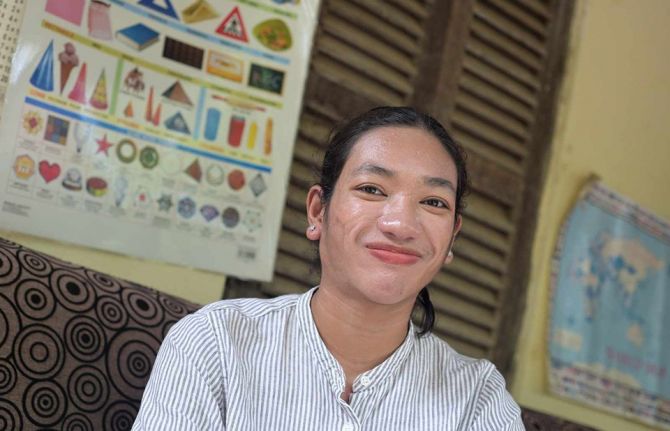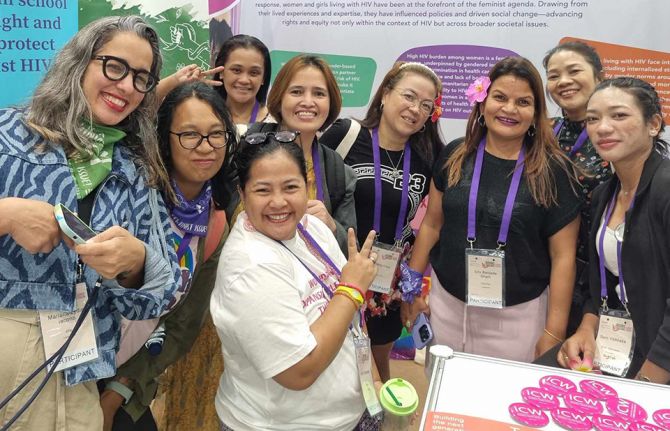
Feature Story
UNAIDS Executive Director praises Iran’s evidence-informed approach to HIV in prison settings
13 October 2010
13 October 2010 13 October 2010
Michel Sidibé meets with H.E. Mohammad Reza Rahimi, First Vice President of the Islamic Republic of Iran. Credit: UNAIDS
In nearly all countries, HIV prevalence among prisoners is significantly higher than in general population. A variety of factors contribute to the spread of HIV in prison settings, including unsafe injecting drug use, unprotected sex, tattooing with contaminated equipment and poor prison health services.
In the Islamic Republic of Iran, HIV prevalence among prisoners is about eight times higher than in the general population. Injecting drug use is the main mode of HIV transmission, accounting for more than 70% of reported HIV cases in Iran.
A visit this week to Iran by UNAIDS Executive Director Michel Sidibé highlighted the country’s progressive work in addressing its HIV epidemic in prisons and among people who inject drugs. Iran’s 250 prisons, rehabilitation camps and juvenile correctional centers house approximately 180 000 inmates. Nearly half of all inmates are imprisoned on drug-related charges.
“What I saw in Qezel Hessar Prison is an evidence-based approach marked by tolerance, pragmatism and compassion,” said Mr Sidibé after touring the largest detention center in the region. “I am impressed with the comprehensive package of HIV prevention, treatment, care and psychosocial support that the prison provides.”
Located near Karaj City, the Qezel Hessar Prison has 19 000 inmates, the majority incarcerated on drug-related offences. The facility offers a wide range of HIV-related services, including opioid substitution therapy, antiretroviral therapy, voluntary testing and counselling, access to condoms and sterile razors, psychotherapy and other behavioral interventions.
Qezel Hessar Prison provides methadone maintenance therapy to more than 2700 inmates on a daily basis, a 30-fold increase since 2003. Like most other prisons in country, married prisoners are allowed conjugal visits with their spouses and are provided with private rooms and condoms.
Executive Director meets senior Iranian officials and people living with HIV
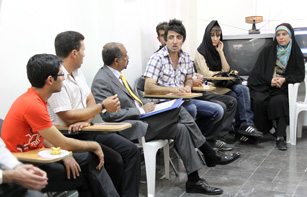
Michel Sidibé meets with a group of HIV-positive people at the "Positive Club" in the Iranian Research Center for HIV and AIDS. Credit: UNAIDS
In meetings with First Vice President Mohammad-Reza Rahimi and other top Iranian officials, Mr Sidibé urged authorities to work towards the goals of “zero new HIV infections among drug users” and “zero newborns with HIV.” Iranian authorities expressed the commitment of the Islamic Republic of Iran to address the HIV epidemic based on the Islamic concept, “If you save one life, you are saving humanity.”
As part of his official mission, Mr Sidibé also visited a “Positive Club” located in the Iranian Research Center on HIV and AIDS. Addressing a group of people living with HIV, he said: “When I hear the words “hope,” “happiness” and “job,” I feel that our efforts have not been wasted.”
During the visit, Mr Sidibé emphasized the work of Iranian health authorities in helping restore the lives and dignity of people living with HIV through the establishment of such Positive Clubs and the provision of information, antiretroviral medicines and other HIV-related services.
Speaking on behalf of people living with HIV, the head of the Positive Club’s council told Mr Sidibé that AIDS is a very difficult area to address. “It requires courage and patience, and you are one of those people who have the courage and patience to work in this area,” he said. “We are happy to have your support, and we are ready to work with you together.”
Region/country

Feature Story
Plan launched to halve TB prevalence and death rates by 2015
13 October 2010
13 October 2010 13 October 2010
The Stop TB partnership has launched a Global Plan to Stop TB (2011-2015) aimed at halving tuberculosis (TB) prevalence and death rates by 2015 to reach the Millennium Development Goal of halting and beginning to reverse the epidemic by 2015.
The Plan, launched in South Africa, identifies research gaps that need to be filled to bring rapid TB tests, faster treatment regimens and a fully effective vaccine to the market. It also shows how public health programmes can modernise diagnostic laboratories and adopt the new TB tests which have become available, replacing the century old diagnostic methods still used in many countries.
The Stop TB partnership are calling for US$ 37 billion to finance the plan from 2011-2015 which they estimate will allow them to diagnose and treat 32 million people over the next five years.
Without dramatic increases in funding and political commitment between 2010 and 2015 the Stop TB Partnership estimates that over 50 million people will develop active TB and that over 10 million lives will be lost to the disease which is both preventable and curable.
Every year around half a million people die from HIV-associated TB. If the plan's targets are met, by the end of 2015, all TB patients will be tested for HIV and, if the test is positive, receive anti-retroviral drugs and other appropriate HIV care. In HIV treatment settings, all patients will be screened for TB and receive appropriate preventive therapy or treatment as needed.
“Over a million people living with HIV fall ill with TB every year,” said Dr Paul De Lay, Deputy Executive Director, Programme, UNAIDS. “We need to make sure that all people living with HIV who need it, receive antiretroviral therapy, and that all people living with HIV are screened for TB every time they see a health care worker. This will help us to prevent diagnose and treat TB early and effectively in people living with HIV and avoid unnecessary deaths.”
In July this year the Joint United Nations Programme on HIV/AIDS (UNAIDS) and the Stop TB Partnership signed a memorandum of understanding to combine efforts to halve the number of people living with HIV who die from TB by 2015, compared to 2004 levels. The memorandum also outlines the importance of providing life-saving antiretroviral treatment for all TB patients living with HIV.
The Global Plan to Stop TB was launched by the South African Minister of Health, Dr Aaron Motsoaledi at a press conference held in the Pholosho Primary School in Alexandra which teaches more than 2000 children from the region.
Following the launch speakers from the press conference, together with children from the school, participated in a football tournament as part of the Kick TB Campaign. This is a campaign which seeks to combat TB as well as the stigma associated with it, by fusing sport and social mobilization to create a platform through which TB messages can be effectively conveyed.
Related

Feature Story
Charity event in Ukraine boosts youth awareness of HIV prevention
12 October 2010
12 October 2010 12 October 2010
Participants in "Race for Life" charity event receive award. Credit: UNAIDS
“A healthy future starts with you” was the slogan of Race for Life, a charity event held on 9 October in Kiev, Ukraine. Over 3000 people gathered in Kiev’s city center to support people living with HIV, raise money for children born with HIV, and express their readiness to join hands to halt the epidemic.
Ukraine is one of the countries most heavily affected by HIV in the region. According to UNAIDS estimates, around 440 000 people are living with HIV in Ukraine, representing over 1% of the adult population. Every day, some 50 new cases of HIV are registered in the country.
In recent years, various sectors of Ukrainian society have united their efforts to respond to the country’s rapidly-growing HIV epidemic. The Ministry of Education, Kiev city administrations, media organizations, the private sector, non-governmental organizations and community organizations were among the organizers of this year’s race.
“Race for Life is a tool for social mobilization in the overall response to the epidemic, especially in public awareness,” said Svetlana Cherenko, Chairman of the Committee on Combating HIV in Ukraine’s Ministry of Health. HIV prevention among youth is one of the country's main priorities.
Initiated by the UN Office in Ukraine in 2001, Race for Life was held annually until 2005. The event was organized again this year to convey healthy lifestyle and HIV prevention messages to youth.
“We must continue talking to young people about HIV transmission, about prevention, about personal responsibility. Everything is in their hands today—their health, their life and their future,” said Denis Broun, UNAIDS Regional Director for Europe and Central Asia, who also ran 3 kilometers in the race.
Related

Feature Story
African law students argue against criminalisation of HIV transmission
12 October 2010
12 October 2010 12 October 2010
Dr Meskerem Grunitzky Bekele, Director of the UNAIDS Regional Support Team for West and Central Africa and Maître Robert Dossou, President of the Constitutional Court of Benin (centre), with students from the winning team of the 19th African Human Rights Moot Court Competition. Credit: UNAIDS
More than 120 young law students from 60 universities representing 24 African countries gathered in Cotonou (Benin) from 4-9 October 2010 to compete in the 19th African Human Rights Moot Court Competition.
Law students argued on a hypothetical human rights case as if they were before the African Court on Human and Peoples’ Rights. Law lecturers served as judges in the preliminary rounds and internationally recognised human rights law experts adjudicated the final round of the competition.
Held in a different country each year, this annual competition was organised by the Centre for Human Rights at the University of Pretoria (South Africa) in collaboration with the UNESCO Chair in Human Rights and Democratisation at the Université d’Abomey-Calavi in Benin.
“The competition provided an amazing opportunity for us, law students, to put our legal training into practice,” said Ms Evy Carole Bouo, from the Université de Cocody (Cote d’Ivoire) who participated in proceedings. “It gave us the chance to meet and interact with prominent African and international legal and human rights experts,” she added.
This year’s hypothetical case raised several human rights issues, including the criminalisation of HIV transmission. Human rights and health experts, civil society organisations and people living with HIV have raised concerns in relation to laws criminalising HIV transmission on the grounds that the overly-broad application of these legal provisions may reinforce HIV-related stigma. Such laws may also deter people from seeking HIV prevention, treatment and care services for fear of prosecution, and may lead to human rights violations.
In their written submissions, students argued, among others, that the overly-broad criminalization of HIV transmission is contrary to the principles of justifiable limitations of human rights provided under the African Charter on Human and People’s Rights and international law.
The removal of “punitive laws, policies, practices, stigma and discrimination that block effective responses to HIV” is one of UNAIDS priority areas as outlined in its Outcome Framework 2009-2011.
During this year’s Moot Court Competition, UNAIDS, UNFPA and UNESCO launched a project, in collaboration with the Centre for Human Rights at the University of Pretoria to compile information on the legal and policy issues relating to HIV and young people in Africa. The project will map laws and policies related to access to HIV-related education for young people, the minimum age of consent to HIV testing, and access to HIV prevention and treatment for young people.
Professor Frans Viljoen, Director of the Centre for Human Rights, noted that this joint initiative with UNAIDS, UNFPA and UNESCO “shows the relevance of the Moot Court Competition for human rights education in Africa and also for getting students involved in a critical research project that can positively influence legal and policy debates in their countries and beyond.”
Speaking at the closing ceremony of the competition, Dr Meskerem Grunitzky Bekele, Director of the UNAIDS Regional Support Team for West and Central Africa emphasised the importance for young law students to get involved in the discussions on complex issues related to HIV and the law.
“An enabling and protective response to HIV that challenges discrimination and empowers all individuals, including young people, to access HIV prevention, treatment and care services is needed today more than ever”, Dr Bekele said.
The inclusion of HIV in this year’s case afforded participants the chance to apply their understanding and knowledge of human rights theory to contemporary issues of concern in Africa such as HIV.
The winner of this year’s competition was the team composed by the Université de Cocody, Côte d’Ivoire (Ms Evy Carole Bouo and Mr Jean-Camille Kouadio), the University of Namibia (Ms Stephanie de Klerk and Mr Albert Titus), and Rhodes University, South Africa (Ms Ingrid Cloete and Mr Fausto Di Palma).
Established in 1992, the African Human Rights Moot Court Competition is the largest annual gathering of law faculties in Africa. It was awarded the UNESCO Prize for Human Rights Education, recognising it as the most far-reaching human rights educational initiative on the continent. Over the past 19 years, it has brought together thousands of students from 131 universities in 48 African countries.

Feature Story
High-level mission urges Vietnam to optimize use of resources to achieve universal access
08 October 2010
08 October 2010 08 October 2010Leaders in Vietnam’s AIDS response urged to optimize resources and focus HIV interventions for key populations at higher risk to help achieve targets for universal access.
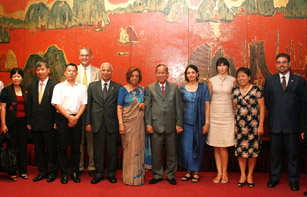
The delegation met with Deputy Prime Minister Truong Vinh Trong. Credit: UNAIDS
A UN high-level delegation headed by the UN Secretary General’s Special Envoy for HIV/AIDS in Asia and the Pacific, Dr Nafis Sadik and Special Advisor to the UNAIDS Executive Director, Mr JVR Prasada Rao visited Vietnam this week to discuss its AIDS response with key stakeholders—including Deputy Prime Minister Truong Vinh Trong, Chairman of the National Committee for AIDS, Drugs and Sex Work Prevention and Control.
The UN high-level mission to Vietnam is part of a regional assessment across countries in Asia and the Pacific taking place over 2009-2010 to improve the effectiveness of AIDS responses in the region.
The HIV epidemic in Vietnam is concentrated among key populations at higher risk. While HIV prevalence among adults aged 15-49 is estimated at 0.44%, prevalence is significantly higher among men who have sex with men, intravenous drug users and sex workers in the country.
Development and provision of a standard package of HIV prevention, treatment, care and support services for key populations of higher risk are among the priority actions recommended by the UN delegation for the country.

The delegation met with People Living with HIV in Hai Phong City. Credit: UNAIDS
Vietnam has seen recent progress in its response to HIV. The country has scaled up needle and syringe programmes over the past two years. In 2009 drug use was decriminalized which has helped create a more supportive environment for harm reduction interventions. The total increase in the number of clean needles and syringes distributed went from two million in 2006 to 24 million in 2009.
A recent study found that 94.6% of male intravenous drug users reported using sterile injecting equipment the last time they injected and HIV prevalence among the drug using population has declined from a high level of 29.4% in 2002 to 18.5% in 2009.
“I am impressed with the strong commitment and leadership showed by Deputy Prime Minister Truong Vinh Trong and leaders of the relevant ministries in addressing HIV,” said Dr Sadik. “This is essential to make policy change happen to scale up access to HIV services.”
“Vietnam should calculate the financial resources needed to support a comprehensive response to HIV up to 2015 and aim to provide at least one third of the total amount from government budgets to ensure the sustainability of the national response,” Mr Prasada said, underlining the delegation’s recommendations.
The UN delegation discussed the national response to HIV with a wide range of stakeholders including National Committee members, donors, local and international civil society organizations, provincial HIV authorities, people living with HIV, people at higher risk of HIV infection and the Joint UN team on HIV in Vietnam.
Civil society representatives underlined the need for increased and sustained resources. “There are two districts in our Hai Phong City still not covered by HIV interventions and people living with HIV there are suffering from stigma, discrimination and lack of access to services,” said Ms. Doan Thi Khuyen, member of a self-help group in their meeting with the delegation.
“I would like you to advise HIV authorities to provide more resources so that services are available in all districts,” she proposed.
The delegation will make recommendations for Vietnam to achieve its universal access targets and the AIDS-related MDG, identify the main gaps and barriers and actions to achieve them, and the financial resources and technical assistance needed.

Feature Story
Food security response to HIV and gender-base violence in northern Uganda
07 October 2010
07 October 2010 07 October 2010
Credit: UNAIDS
The fertile northern region of Uganda was known for many years as one of the granaries of the country, consistently producing surpluses for local and international food markets. But two decades of civil conflict between the Uganda People’s Defense Forces (UPDF) and the Lord’s Resistance Army (LRA) have left the Acholi and Lango sub-regions destitute.
Between 1986 and 2006 an estimated 1.8 million people fled from their villages to the shelter of temporary camps. In Kitgum, Gulu, Pader and Amuru districts an estimated 95% of the population lived in such camps.
The war caused significant setbacks in education, healthcare, food production and infrastructure. It also increased vulnerability, particularly amongst girls and women, as well as gaps in HIV service provision to the internally displaced persons (IDPs).
"They have lost almost everything, their assets, their livelihoods. They have lost their skills. You know, they were used to farming and staying in the camps meant that a whole generation lost out on those skills”, says Winifred Nalyongo, a livelihoods specialist with the United Nations Food and Agriculture Organisation (FAO).
In 2006, internally displaced persons began returning to or near their places of origins following the singing of a Cessation of Hostilities Agreement between the Government of Uganda and the LRA. The UN refugee agency (UNHCR) estimated that more than 70 per cent of all internally displaced persons had returned home or in transition camps in January 2009.
HIV and gender-based violence in early recovery settings
It is in this early recovery setting that FAO has been working to re-establish the livelihoods of the communities impacted by the conflict through the Farmer Field and Life Schools (FFLS) and Junior Farmer Field and Life Schools (JFFLS) programmes. These involve a group learning process whereby women and men farmers learn valuable agricultural and life skills that allow them to improve their livelihoods and reduce their vulnerability to food insecurity, HIV and gender-based violence, among others.
Conflict and displacement are known to be factors in heightening exposure to HIV. In the Northern Ugandan IDP camps, alcoholism and sexual violence are widespread. FAO representatives indicate that forced in a situation of idleness and unable to feed their families men may become frustrated and turn to alcohol, thus exacerbating existing gender inequalities, making women and children more vulnerable to HIV.

Credit: UNAIDS
The UNAIDS/UNHCR policy brief on HIV and refugees mentions that, as refugees struggle to meet their basic needs such as food, water and shelter, women and girls are often forced to exchange sexual services for money, food or protection. Children living without parental support, whether due to separation from or death of family members, are also particularly vulnerable to sexual and physical violence and exploitation.
A 2005 UNICEF study in one of Northern Uganda’s largest IDP camps found that six out of ten women were physically and sexually assaulted by men.
According to a 2004-2005 Ministry of Health survey, HIV prevalence in the war-affected areas of Northern Uganda is at 8.3% compared to the national average of 6.4%.
Reducing vulnerability
FAO’s Farmer Field and Life Schools place strong emphasis on food security and self-reliance as a means to reduce vulnerability to HIV and gender-based violence. They emphasize farming as a business, encouraging members to generate money from their crops, but also teach valuable life skills such as gender sensitivity, child protection, hygiene, nutrition and HIV awareness.
People living with HIV are encouraged to join the FFLS where they receive nutrition training, an important component in HIV positive living. They can also learn how to farm less labour intensive crops such as okra or vegetable gardens.
Learning new skills early on
In Dubaju village, FAO’s Junior Farmer Field and Life Schools help orphans and vulnerable children to become more self-sufficient and improve their food security. They also learn about staying healthy and protecting themselves from HIV through classroom-based discussions. For example, children learn how to protect crops from pests or treat diseased crops and draw parallels with how they can take care of their bodies and prevent themselves from becoming infected with HIV.
Related

Feature Story
President of Mali committed to AIDS response
05 October 2010
05 October 2010 05 October 2010
From left to right: Michael Sidibe, UNAIDS Executive Director; UN Secretary-General Ban Ki-moon; H.E. Amadou Toumani Touré, President of Mali and Global Fund Executive Director Prof. Michel Kazatchkine with the Born HIV Free signature book. Credit: The Global Fund/John Rae
The President of Mali, His Excellency Amadou Toumani Touré, is on a three-day visit to the United States to reinforce his country’s commitment to the AIDS response. The President is participating in the Global Fund’s Replenishment conference, taking place on 4 and 5 October and is meeting with a number of high ranking officials from the United Nations and the US administration.
Public and private donors from over 40 countries will reaffirm their commitment to the work of the Global Fund by announcing funding pledges for 2011 to 2013 at the Global Fund’s Third Voluntary Replenishment and pledging conference which is being chaired by the UN Secretary General Ban Ki-Moon. The President of Mali will be the highest country representative at the conference and will bring a regional perspective to the proceedings.
The Global Fund provides a quarter of all international financing for AIDS globally, two-thirds for tuberculosis and three quarters for malaria. Ahead of the Conference, the Global Fund announced ahead that it will need 17 billion to sustain, and 20 billion to scale up the response to the three diseases.
As well as participating in the conference the President of Mali met with the UN Secretary General to discuss building stronger relationships between the United Nations and Mali. He also met with Ambassador Eric Goosby, Global AIDS Coordinator with the U.S. Department of State. During their meeting Ambassador Goosby congratulated the President on Mali’s successes in responding to its epidemic.
Mali has shown strong leadership in the response to the epidemic and investments are starting to show results––Mali has seen a drop of more than 25% in new infections and has reached 65% coverage of antiretroviral therapy.
On the second day of his visit the President of Mali will meet Anthony Lake the Executive Director of the United Nations Children’s Fund.

Feature Story
More than a game: using football to promote health issues in Uganda
30 September 2010
30 September 2010 30 September 2010A version of this story first appeared at www.unfpa.org
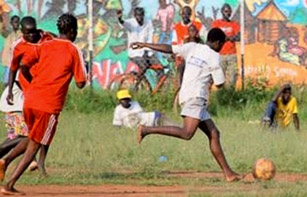
The UNFPA-sponsored football tournament offered a way to get the attention of young people in northern Uganda. Photo: Stijn Aelbers/UNFPA Uganda
Although hostilities in northern Uganda ceased in 2006, the lives of young people, formerly targets for abduction by the Lord’s Resistance Army, have not been easy. During the conflict, which lasted more than 20 years, many children spent their early years confined to camps for displaced persons, while others were subjected to trauma, brutality and suffering as child soldiers.
Prolonged instability also took a toll on health and social support systems: reproductive health indicators in the sub-region are among the lowest in the country, and gender-based violence is common.
While the majority of youth—who comprise 56 % of Uganda’s population—live in poverty with few educational or employment opportunities, football is one thing that they can get excited about and that allows them to forget about their troubles. Florence, age 23, from a squad in Gulu District said, “If we come to play football we forget our problems at home. It is like stress management.”
At the Acholi Football Tournament, which took place in five districts, and was supported by UNFPA, the United Nations Population Fund, the goal was to do more than more than help young people relax. It also aimed to reduce teenage pregnancy and gender-based violence, two of the most serious problems in the area.
Referees, coaches, and team captains attended training sessions on the issues, and then became a resource for information, discussion, and guidance. Subsequent dialogue sessions reached some 1,200 players.
Top local officials awarded the winning teams with uniforms that read, “Say no to GBV (gender-based violence) and teenage pregnancy.” Health care workers were also on hand to answer questions and provide health counseling. Over the course of two days, some 10,000 condoms, most supplied by UNFPA, were distributed by health workers and peer counsellors as well as representatives of the Boda Boda Association, which employs many young men as motorcycle taxis drivers.
More than 800 individuals, mostly young men, took advantage of the free voluntary testing and counselling that was offered to allow them to check their HIV status.
Women were also on the pitch, although many are less experienced than their male counterparts, spectators say the buzz of the women’s matches created were a demonstration of the growing popularity and re-thinking of gender roles
A player from the Lalogi team said she has encountered negative attitudes. (See how these are addressed in a new electronic football game.) However, 21-year-old Rose said her husband was supportive: “He is happy that I play. I think he is here watching today,” she shouted over her shoulder as she ran onto the pitch for kick-off.
Related

Feature Story
Mobility, migration and vulnerability to HIV along the ports of the Red Sea and the Gulf of Aden
28 September 2010
28 September 2010 28 September 2010
H.E. Ismail Omar Guelleh, President of the Republic of Djibouti together with Mr Michel Sidibé, UNAIDS Executive Director. Credit: UNAIDS/P.Virot
Each year, there are more than 200 million people on the move. The UN estimates that between 20 and 30 million are migrants in irregular situations and that wars and conflicts have caused the displacement of 16 million refugees.
Many countries around the Red Sea and Gulf of Aden are affected by intense poverty and violent internal conflicts. This has resulted in large numbers of migrants living in and around the ports. There is also a large community of mobile populations, including truck drivers, dock workers, port staff, security staff, ships crews and sex workers who can be at higher risk of exposure to HIV.
Poverty, social exclusion; separation from families and communities, loneliness, fear and marginalization can make mobile populations and migrants particularly vulnerable to HIV. The situation can also be aggravated by lack of access to HIV prevention, treatment and care services.
“It is essential that mobile and migrant populations living in and transiting through ports have access to HIV services and are included in national HIV plans,” said Michel Sidibé, Executive Director, of the Joint United Nations Programme on HIV/AIDS (UNAIDS). “Achieving universal access goals means making sure all sectors of society are reached, particularly people most vulnerable to infection.”
The Government of Djibouti, in close collaboration with UNAIDS, the International Organization of Migration, the Inter-Governmental Authority on Development (IGAD), and other partners, convened a meeting from 26-29 September 2010, which brought together leaders from Red Sea countries and other countries across Africa to address the issue of key populations at higher risk of HIV infection along the Red Sea and the Gulf of Aden ports.
“For us, this conference has been extremely instructive, we have learnt a lot from the experts, but particularly from people living with HIV who have come forward to tell us their stories,” said His Excellency Abdallah Abdillihi Miguel, Minister of Health of Djibouti. “This meeting has reinforced my conviction that we have to continue to work towards universal access to HIV prevention, treatment, care and support and make sure that everyone in need, even those most marginalised and vulnerable, has access to services.”
The experts and leaders agreed to take concrete actions to strengthen advocacy and leadership on HIV and mobility; integrate HIV and mobility into national strategic plans; ensure improved planning; enhance the capacity of civil society and partnerships with the private sector; and develop a common communication strategy with particular emphasis on human rights.
Related

Feature Story
Women in African Parliament to accelerate action on gender and HIV
28 September 2010
28 September 2010 28 September 2010
Woman participating in debate in Senegal. Credit: UNAIDS/P.Virot
The Global Power Africa conference opened on September 26 in Washington D.C. The event brought together women Members of Parliament and Ministers from twelve countries in Africa, to develop strategies to support the implementation of the UNAIDS Agenda for Accelerated Country Action for Women, Girls, Gender Equality and HIV at country level.
The meeting, held within the framework for the regional Partnership Of Women Elected/Appointed Representatives (GlobalPOWER®) program, was convened by UNAIDS in partnership with the Center for Women Policy Studies.
UNAIDS Deputy Executive Director, Management and External Relations, Ms Jan Beagle, opened the event by highlighting UNAIDS’ commitment to work with parliamentarians on developing strategic and results-oriented National Plans on HIV at country level.
“There is a lot of power in this room,” Ms Beagle remarked. “As women, you have the ability to speak for the marginalized – as Michel Sidibé says; you are the voice of the voiceless.”
Ms Beagle stressed the consensus on the need for women-centered approaches that emerged at the Millennium Development Goal summit held in New York 20-22 September. Participants at the summit underscored that without investments in women the MDGs would not be reached.
According to Ms Beagle, UNAIDS believes in the importance of linking gender to all MDGs, as part of the integration of responses to maximize resources for broader health and development outcomes—the AIDS plus MDGs approach.
“We must work with great diligence and care to elevate the status of women and to successfully reduce the burden of HIV. Zero new infections! Zero discrimination! Zero AIDS-related deaths!,” Ms Beagle said.

